Okay, now that we have that part out of the way, let's get to the build quality.
The D300s is built like a tank, but doesn't weight like one. I wasn't able to test the weather sealing so I can't vouch for it but I am confident the D300s can take on light drizzle (light enough to make others run for cover but not heavy enough to stop a birdnut)
The ergonomics is okay. I am okay with the way the controls are situated EXCEPT for the shooting dial that I need to press a release button before I can choose between the shooting modes.
The grip's material though, doesn't really fit me well. Maybe it's just me but I don't really like the feel of the rubber.
The ports, doors and connectors are placed quite strategically EXCEPT the microphone. I took a short video and was thoroughly enjoying that the D300s can autofocus during video recording until.. I played the video back.
The mic recorded the sound of.. the lens' motor! AAHHHHH!!!!!
External mic is a must.
And now, the juicy parts.. the Image Quality and the Auto focus.. next week. :)
Saturday, March 6, 2010
Battery Life on the D300s
Let's now move to battery life and why I hold this so important. For other photographers, they can shoot while the second battery is charging and swap whenever they want. This is a luxury that I don't have when photographing birds in the wild. One needs to carry a spare battery, and both of them needs to be dependable.
The brochure on the D300s says that the battery shoots up to 950 images. That scared me. That's only half a day of birding for me :) So I intentionally full-charged the demo unit I had and carried the batteries of my D90 as backup.
Lo and behold, I went up to close to 1,900 photos with one bar/stripe still left in the power meter. I am not saying the brochure lies, there are factors that affects battery life.
Of course the battery I was using is brand new and SHOULD perform well. Also, have I mentioned that I shoot in bursts? 1,900 shots is one day, one whole day of bird photography. So you can view this as either one of the two..
The battery lasted for only a day
or
The battery shot close to 1,900 images :)
The brochure on the D300s says that the battery shoots up to 950 images. That scared me. That's only half a day of birding for me :) So I intentionally full-charged the demo unit I had and carried the batteries of my D90 as backup.
Lo and behold, I went up to close to 1,900 photos with one bar/stripe still left in the power meter. I am not saying the brochure lies, there are factors that affects battery life.
Of course the battery I was using is brand new and SHOULD perform well. Also, have I mentioned that I shoot in bursts? 1,900 shots is one day, one whole day of bird photography. So you can view this as either one of the two..
The battery lasted for only a day
or
The battery shot close to 1,900 images :)
Frame Rate of the D300s
Alright.. fast frame rate will not turn the head of portrait photographers, maybe. But for those like me, who shoot avian photos.. fast frame rate or "bursts" as I like to call it, is really close to a must. For a couple of reasons.
First, even shooting static birds (those standing or perched still like bitterns or kingfishers), needs a good frame rate. Why? Shooting in bursts of three or four shots greatly helps reduce mirror slap. Well not really reduce the slap, it will of course be there, but the effect it has on the image is minimized. There is another technique called the Mirror Up Shooting but that's for a different blog.
Secondly, birds, unlike models, will not stand still for you. They will do whatever they want, whenever they want. And most of the time, they will only perch still, for just a few seconds. And pulling off as many shots as you can in the least amount of time, will increase the chances of you capturing a nice image.
Third, birds in flight. Flying birds move at a very different rate. Some are fast fliers and some are gliders. For gliders, 4-6 fps is okay, but for those who flap their wings.. you will need to shoot faster. Imagine if your camera shoots 4frames per second and the bird flaps its wings also at 4frames per second, then you shoot for two seconds.. you end up with 8 pictures of the bird with the wing in the same (or relatively same) position. You will want to have pictures of the top and bottom of the wing.
For this part of avian photography, the D300s performs exceptionally. Rated at 7-8 fps (with optional battery grip), it shoots rapidly enough to catch those crucial moments.
Just look at these and see for yourself


http://farm3.static.flickr.com/2787/4411261196_81b0be1639_o.jpg




First, even shooting static birds (those standing or perched still like bitterns or kingfishers), needs a good frame rate. Why? Shooting in bursts of three or four shots greatly helps reduce mirror slap. Well not really reduce the slap, it will of course be there, but the effect it has on the image is minimized. There is another technique called the Mirror Up Shooting but that's for a different blog.
Secondly, birds, unlike models, will not stand still for you. They will do whatever they want, whenever they want. And most of the time, they will only perch still, for just a few seconds. And pulling off as many shots as you can in the least amount of time, will increase the chances of you capturing a nice image.
Third, birds in flight. Flying birds move at a very different rate. Some are fast fliers and some are gliders. For gliders, 4-6 fps is okay, but for those who flap their wings.. you will need to shoot faster. Imagine if your camera shoots 4frames per second and the bird flaps its wings also at 4frames per second, then you shoot for two seconds.. you end up with 8 pictures of the bird with the wing in the same (or relatively same) position. You will want to have pictures of the top and bottom of the wing.
For this part of avian photography, the D300s performs exceptionally. Rated at 7-8 fps (with optional battery grip), it shoots rapidly enough to catch those crucial moments.
Just look at these and see for yourself


http://farm3.static.flickr.com/2787/4411261196_81b0be1639_o.jpg




Tuesday, March 2, 2010
Reviewing the D300s for Bird Photography
Just recently, CDSC, the local distributor allowed me to road test the new Nikon D300s. I know, I know it is a bit (about 6months) late as it has been in the market since late 2009. The reason for the review is for Wildlife, particularly Bird Photography.
Having used both the D300 and the D90 in avian photography, I was understandably excited to try out the D300s as for me, it is the combination of these two very successful bodies into one.
The parts that I would like to test are:
1. Frame Rate
2. Battery Life
3. Build
4. Image Quality at high ISO
5. Autofocus mechanism
Why?
1. Frame rate - for BIFs (Birds In Flight), fast frame rate is nice to have. When the wing beats up and down at a rate of 4 full beats per second, shooting at 4 frames per second means you will capture the wing in one position. It would be nice to capture the wing from upstroke to downstroke.
2. Battery life - this MUST be long. being in the field for a whole day and shooting sometimes in excess of a thousand pictures is normal. And you will need a good battery for that.
3. Build - the body needs to be rigid. Enough to handle a birdnut :)
4. Hig ISO IQ - needs to be clean. Most birds stay in the shade and flash is only for last resort. yes you can slow down the shutter speed, if you can tell a warbler to sit still for half a second. Avian photography needs clean high ISO shots to still enable fast shutter speed shooting.
5. AF - autofocus needs to be sticky.. specially for birds in flight. Shooting at a fast frame rate is only half the story. If your camera can't acquire the target, you won't be shooting any frames. And if you shoot off focus, at 8frames per second, it just took you one second to waste 8frames.
My test is still ongoing and this blog is only to open up the topic. I will be adding more and pictures as the week goes on.
Bit there is one thing that I would like to make sure, that I will do different from other reviews. Most reviews would compare the D300s to another camera, say, the D90 and/or the D300. But I won't. I will give it as straight as it can be, as a camera review, not a comparison.
So hold on and give me a few days to process the images I took :)
Having used both the D300 and the D90 in avian photography, I was understandably excited to try out the D300s as for me, it is the combination of these two very successful bodies into one.
The parts that I would like to test are:
1. Frame Rate
2. Battery Life
3. Build
4. Image Quality at high ISO
5. Autofocus mechanism
Why?
1. Frame rate - for BIFs (Birds In Flight), fast frame rate is nice to have. When the wing beats up and down at a rate of 4 full beats per second, shooting at 4 frames per second means you will capture the wing in one position. It would be nice to capture the wing from upstroke to downstroke.
2. Battery life - this MUST be long. being in the field for a whole day and shooting sometimes in excess of a thousand pictures is normal. And you will need a good battery for that.
3. Build - the body needs to be rigid. Enough to handle a birdnut :)
4. Hig ISO IQ - needs to be clean. Most birds stay in the shade and flash is only for last resort. yes you can slow down the shutter speed, if you can tell a warbler to sit still for half a second. Avian photography needs clean high ISO shots to still enable fast shutter speed shooting.
5. AF - autofocus needs to be sticky.. specially for birds in flight. Shooting at a fast frame rate is only half the story. If your camera can't acquire the target, you won't be shooting any frames. And if you shoot off focus, at 8frames per second, it just took you one second to waste 8frames.
My test is still ongoing and this blog is only to open up the topic. I will be adding more and pictures as the week goes on.
Bit there is one thing that I would like to make sure, that I will do different from other reviews. Most reviews would compare the D300s to another camera, say, the D90 and/or the D300. But I won't. I will give it as straight as it can be, as a camera review, not a comparison.
So hold on and give me a few days to process the images I took :)
Sunday, February 21, 2010
My Urban Swamphen
Just recently, I discovered that in a nearby swamp here where I live, there lives a Purple Samphen.
The swamp is actually a Black-crowned night Heron colony, with dozens upon dozens of Night Herons nesting there. I love taking pics of the herons there as they are all so clean and neat! Signs that they are living there, thriving, and healthy.
Aside from the BCNHs, other species I see there are:
Black-Crowned night Heron
Barred Rail
Yellow bittern
White-breasted Waterhen
Common Moorhen
Common Kingfisher.
Purple Swamphen
The Purple Swamphen is a great treat for me as the only other place I know where I can see it is in Candaba, Pampanga.
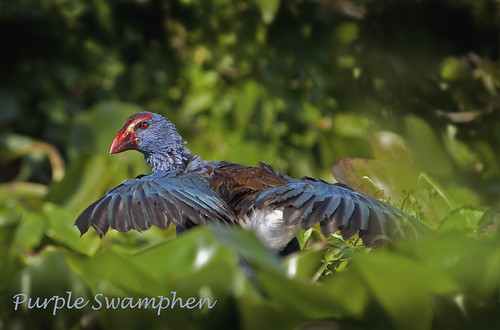
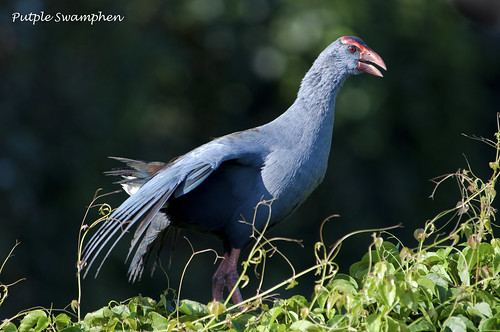
I have seen two of them at the same time, and suspect that there is a third because I have seen one that is smaller than these two.
I am so happy to report this sighting! As you can see by the photo, they are both quite healthy!
Here are some photos of the Night Herons..
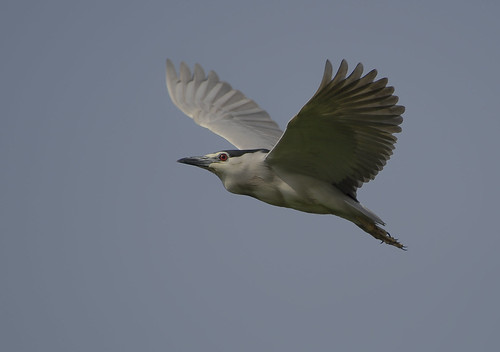
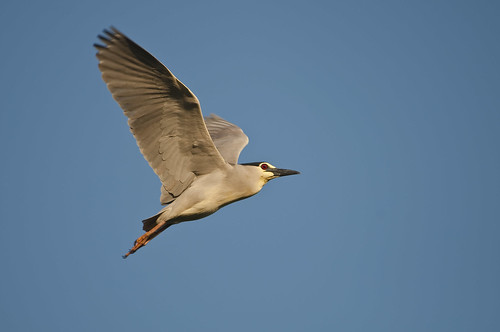
The Waterhen
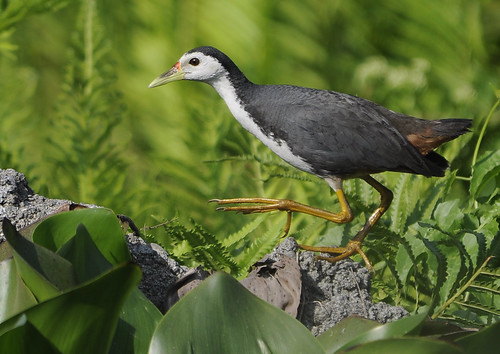
Thanks for reading!
The swamp is actually a Black-crowned night Heron colony, with dozens upon dozens of Night Herons nesting there. I love taking pics of the herons there as they are all so clean and neat! Signs that they are living there, thriving, and healthy.
Aside from the BCNHs, other species I see there are:
Black-Crowned night Heron
Barred Rail
Yellow bittern
White-breasted Waterhen
Common Moorhen
Common Kingfisher.
Purple Swamphen
The Purple Swamphen is a great treat for me as the only other place I know where I can see it is in Candaba, Pampanga.


I have seen two of them at the same time, and suspect that there is a third because I have seen one that is smaller than these two.
I am so happy to report this sighting! As you can see by the photo, they are both quite healthy!
Here are some photos of the Night Herons..


The Waterhen

Thanks for reading!
Friday, January 22, 2010
Candaba, January 2010
First real birding sortie of the year and it was great! Not only was I able to capture some birds for the first time, I was also able to meet with a lot of other bird photographers that I admire.
We started off relatively late this time. We were there before 7am. This is okay since during the winter solstice, the sun doesn't really shine until "late" morning.
First bird I got was a roadside Striated Grassbird
Not really a new bird as I already have a lot of pictures of this but this one is unique for me as this is a full frame capture :)

Then off to the wetlands we forged on!!! On the hunt for the Philippine Duck (Anas Luzonica). As I have been birding for only a year, I still don't have a nice picture of this species. I was really hoping to get a good one.
The ducks weren't flying and pretty far when we got there. But I was able to spot and photograph a first timer for me.. a Purple Swamphen
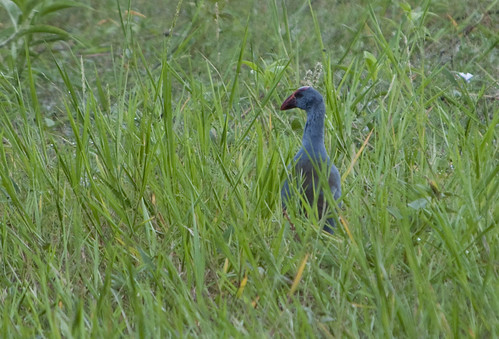
it's not everyday that I see a purple bird :)
Then the Common Moorhen showed itself to me and I took some quick snaps of it swimming along the banks at the other side

Then.. the ducks started flying and I was snapping away in delight!!!

they are sooo lovely. Looking like they are smiling
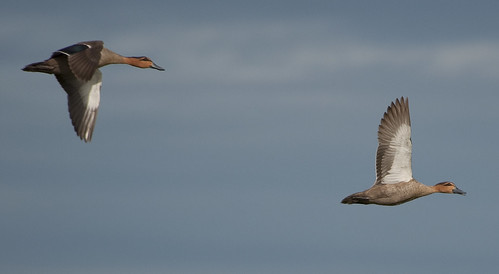
Then my D90 gave me a few shots that are considered more difficult than these. Birds flying with a busy background..
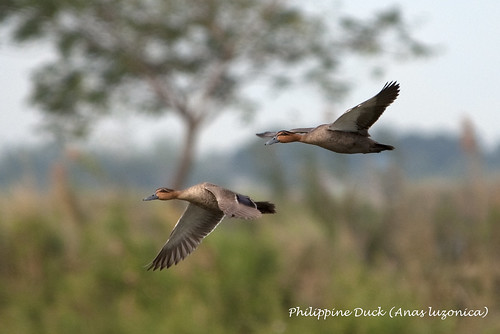
There were also some first time ducks like these Garganeys
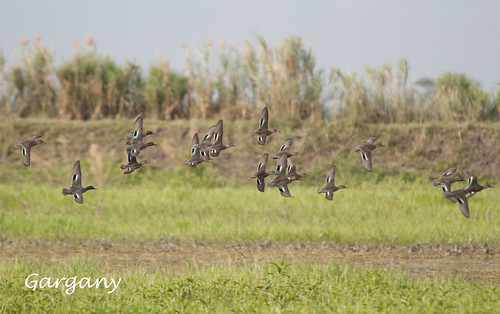
and Northern Pintails
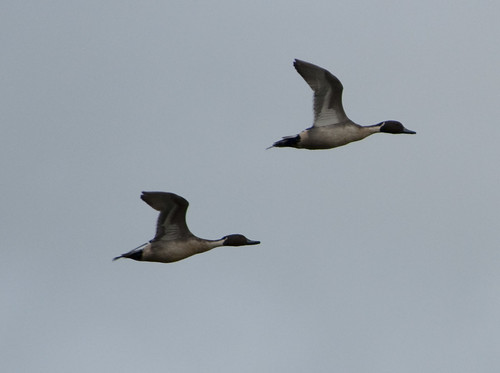
There were also several Green-winged Teals
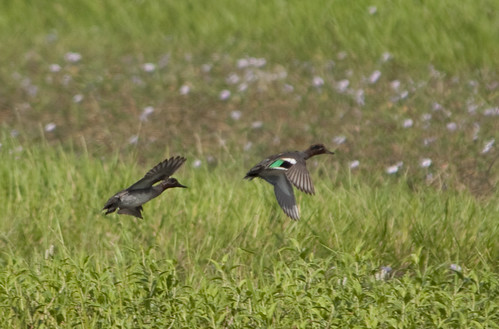
Then I moved forward for lunch and was blessed with these captures of a female Pied bushchat
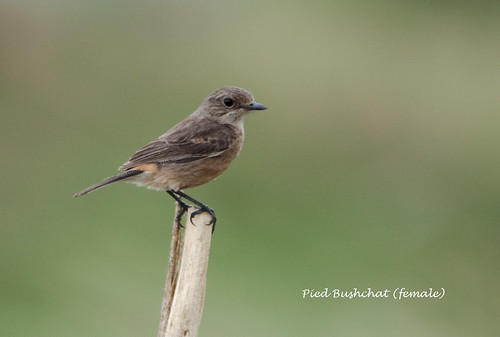
and a nest of baby Zebra Doves

then the day was topped off by a lifer.. a picture of a flying White-breasted Waterhen
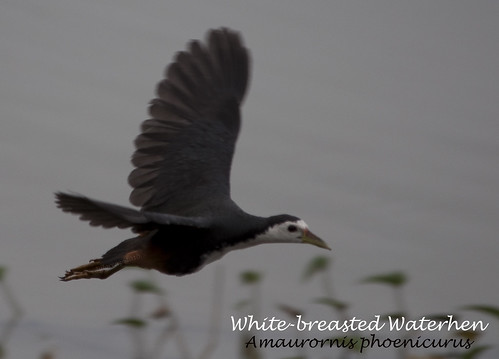
I was shooting so many birds in flight that I finally had the courage to take a picture of one of the faster birds.. the Swallow..
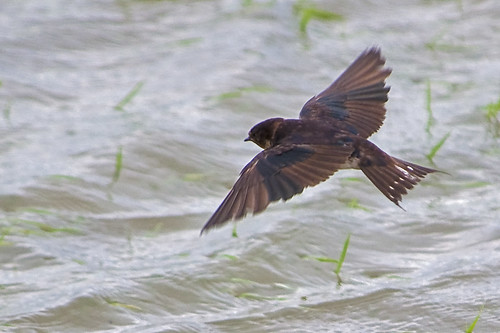
We started off relatively late this time. We were there before 7am. This is okay since during the winter solstice, the sun doesn't really shine until "late" morning.
First bird I got was a roadside Striated Grassbird
Not really a new bird as I already have a lot of pictures of this but this one is unique for me as this is a full frame capture :)

Then off to the wetlands we forged on!!! On the hunt for the Philippine Duck (Anas Luzonica). As I have been birding for only a year, I still don't have a nice picture of this species. I was really hoping to get a good one.
The ducks weren't flying and pretty far when we got there. But I was able to spot and photograph a first timer for me.. a Purple Swamphen

it's not everyday that I see a purple bird :)
Then the Common Moorhen showed itself to me and I took some quick snaps of it swimming along the banks at the other side

Then.. the ducks started flying and I was snapping away in delight!!!

they are sooo lovely. Looking like they are smiling

Then my D90 gave me a few shots that are considered more difficult than these. Birds flying with a busy background..

There were also some first time ducks like these Garganeys

and Northern Pintails

There were also several Green-winged Teals

Then I moved forward for lunch and was blessed with these captures of a female Pied bushchat

and a nest of baby Zebra Doves

then the day was topped off by a lifer.. a picture of a flying White-breasted Waterhen

I was shooting so many birds in flight that I finally had the courage to take a picture of one of the faster birds.. the Swallow..

Subscribe to:
Posts (Atom)